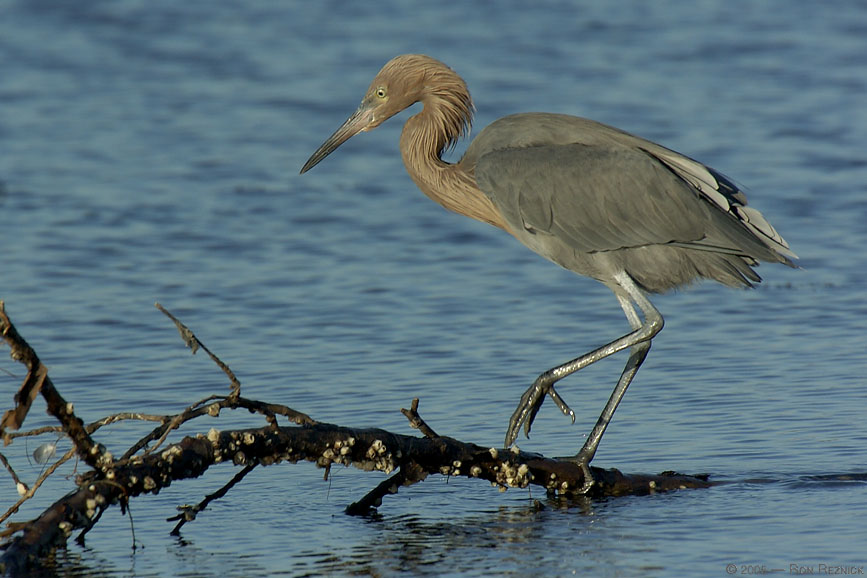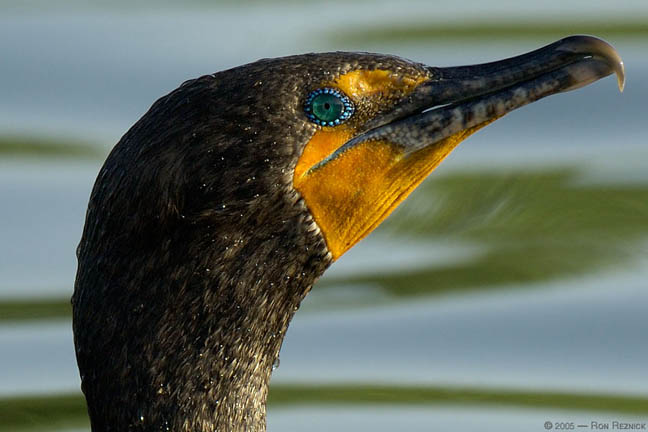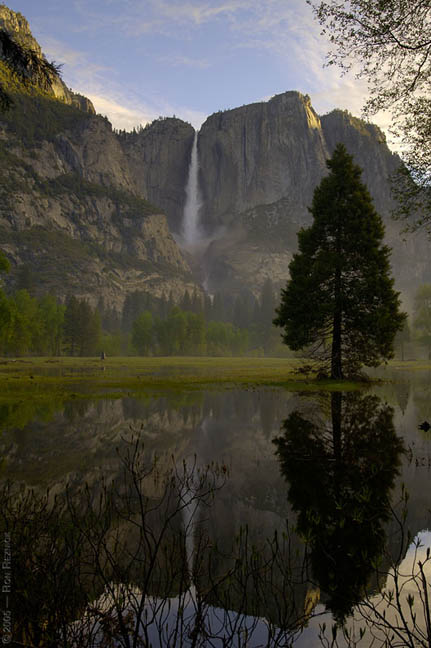



 |
 |
 |
 |
We are trying to develop a community where photographers can come and discuss nature, wildlife and pet photography related matters. We encourage you to enter the forums to share, make comments or ask questions about this interview or any other content of NWP.
This article is Copyright 2005, James Morrissey, and may not, in part or in whole, be reproduced in any electronic or printed medium without prior permission from the author. The images in this article are the property of Ron Reznick and have been licensed to James Morrissey and the NWP Photo Forum for the purpose of this interview.
Editor's Note: A link is at the end of the page if you wish to learn more about Ron Reznick and his work.
Part III: Ron in the Milieu
 |
Reddish Egret (c) Ron Reznick
JM: Do you see yourself as both a photographer and an environmentalist?
RR: In preserving the environment, or doing active work? Can you define that a bit more? The word ‘environmentalist’ is a big word.
JM: Sure. What I am wondering is, do you see yourself as someone who is actively (or passively) preserving some portion of the environment that is endangered or threatened?
RR: That is a difficult question. It is still a bit vague. Let us see how I can attack this. When you make people aware of something that they are not aware of, you are helping to enhance the understanding of that thing. Let us use the example of shooting something that people are not normally aware of. You may have done something to assist or reduce the impact against that something – was that vague?
JM: Absolutely. :) My question was vague though, so I guess I get what I deserve.
RR: [chuckles] Let us use the example of baby seals in the arctic. Let us say that you shoot a piece showing the flagrant attack on baby seals in the arctic.
JM: You mean like the famous National Geographic piece?
RR: Yes. I was picking that exact topic. They made people aware of the problem. Some of whom are going to be active in preventing this from happening in the future. The person who did this absolutely helped alert people and preserve the environment. It allowed the photographer to cause an emotion that created an action. So, anything that you do to present a subject to the public, that helps elicit an action, can be construed as a means of assisting the environment.
JM: Do you see yourself as actively trying to do so – and if so, in what ways?
RR: I love what I am doing – or I would not do it. To a certain extent, I try to put myself into a position where I am doing something I have not yet done as often as possible. Occasionally, I find something that just strikes me and I attempt to select, for presentation to the public, things about the subject that strike me, and hope that what I am showing them will strike them as well.
JM: I saw that you have donated some of your work to some wildlife agencies.
RR: If people (in non-profit organizations) are working on something that I would like to help with, ask for something that I can supply, I give them what they need. However, ultimately, I am not actively attempting to support an environmental agenda in particular. There are a large number of people who spend a major portion of their time being activists – supporting and creating causes. I do not do that. What I do, on the other hand, is try to make people part of my world through photography. Whether or not that is something that is valid as part of this conversation – that is your decision.
I am just happy to be a part of this because I love it. If I can touch someone else, great. If I cannot, well, I tried. That is what I am after. I am not trying to be an environmental activist. WHEW.
JM: It wasn’t that bad, was it?
RR: Thank God! Now, I definitely try to not impact negatively on the environments I work in and the subjects I deal with. This does not mean, though, that I am trying to be the Robert Segal or Jane Fonda of the environment.
JM: I am not Fonda Jane.
RR: [laughs] That is a good one.
JM: I wish I could take credit for it.
RR: I left the 70s with a sense of wonder. :) Anyway, I want to be part of the environment without forcing my views on anyone else. I may not be as big a person as some of these folks by focusing on the things I want to focus on. I hope that I am not seen as smaller by not being a part of the ‘bigger scene.’ I don’t want to be part of that.
JM: Would you say that it is a goal of yours to not interfere with the subjects/milieu you are dealing with.
RR: Yes. One of the things that really upsets me is the trashing of the environment. You walk around some of these tremendously beautiful places and you see these people who are so into themselves that they turn everything they touch into a giant trash heap. The other thing is that I hate seeing people who disturb the wildlife.
JM: You mean like the couple who wants to take the picture next to the Elk?
RR: Have you ever heard of Charger?
JM: No.
RR: Since we were talking about Yellowstone earlier, I assumed that you were making reference to Charger. :) This is a particular elk near Madison Junction. He should be a 7 pointer this year. He hangs out by the Norris Geyser basin near the Ranger Station (in that meadow north, across Canyon). The meadow on the left side when you're heading towards the canyon (the one that the Gibbon River goes through) is Charger’s territory. He is a very aggressive elk that sometimes has a harem of 20 or 30 females. He is famous for going after stupid tourists.
JM: My dream picture. :) So, back to the ranch. It sounds like really your goal then is to often be there as a recorder and not interfere with the wildlife and its environment.
RR: Well, let me qualify that. People who know me know that I will often stalk in close – real close, but carefully. I try to do it in a way that does not impact the animal.
 |
Double Crested Cormorant (c) Ron Reznick
JM: How close?
RR: The 25 yard zone on a pronghorn. When the animal becomes aware of you and raises its hackles, you are in too close. OK, how much do you know about animals?
JM: It depends on the animal :) Where are you going with this?.
RR: You know how you radiate – let’s be very 60s - pleasant or non-threatening vibes? I have found that I can get very close to the critters, well within their fear radius, and they won’t run because of how they feel about me. They do not see me as threatening. They may raise their hackles. But, they realize that I am not a threat and they will not run. The lesson is, “If you are not in tune with the animal, you cannot get that close to the animal.”
You need to be respectful of their space or else, they will run from you. Of course, some animals are more aggressive than others. I would never get that tight on a bear. However, if you are in position and the bear comes in on you and you do not move, you may get closer. However, the bear is coming in on YOU.
I have a story for you. I was in Yellowstone once with my wife. A new baby bison – a week old – still had the umbilical cord attached. Mom and baby were outside the herd. There was a tree right next to the baby – and a set between me and the baby. The herd is to my left, mom and baby are in front of me about 75 yards ahead. I move forward using the trees as a blind, making sure not to be able to see mom’s head. I stepped past the tree, watching the mother, and finally stopped about 20 feet from the baby – I am shooting a 300mm lens (more than filling my frame with a week old baby). I had the herd to the left and the alpha-male sees me. If the male approaches me without stopping to graze, I am in trouble. If he is approaching and stopping to graze, I am OK.
JM: What we are talking about is having a firm knowledge of animal behavior.
RR: No shit. I have learned this through observation. The guy approached me to check what I was doing and to bring the female and baby back into the herd. As long as he stopped to graze, I was OK. If I was impacting negatively, I would have been attacked. It is harder to do that when you are with someone who does not understand the critters. I have gotten in very close - with clients - to normally ornery animals like moose. The trick is to not move -- and to allow them to approach you. By the way, it's a darned good idea to stay reasonably close to a tree when you're around animals like moose and bison. I've found myself scooting over to a tree when I was surprised by a migrating bison herd that was funneling down a space-limited river bank while I was shooting river otters, for instance, and getting my back up against that tree (with the tree between me and the bison) kept me from being squished.
JM: Do you ever worry about your liability? You are within 25 feet of a bull moose and your client gets slammed?
RR: That would be a problem. Hopefully, we could get them behind a tree in a hurry. I would definitely sacrifice their equipment to keep them safe. I try very hard to get a feel for people – just like I would with the critters. If I feel uncomfortable with them when I am training them during the first day, I will NOT take them close. By the way, I only do that when I'm working with one person -- you simply cannot get a group in as close because you cannot control a group as well, and the group appears to be a larger problem to the animal(s).
JM: So you have to adjust your teaching techniques not only upon the animal, but the person that you are teaching.
RR: Absolutely. If I am with a large group or a city guy who does not know how to walk in the weeds or shut up, I will not take them close. Also, they need to be able to pay attention to something other than themselves.
JM: Do you feel that this is an important part of your training – to teach them to be outside of themselves?
RR: No. You cannot do that in a couple of days. What you are talking about takes months. You cannot teach people how to be aware of their environment overnight. There is just no way. They need to be able to pay attention to things around them.
 |
Yosemite Falls Reflection (c) Ron Reznick
JM: Since we tossed out the environmental program earlier, would you want to talk about some of the places that you like to photograph most?
RR: Obviously these things change at different times of year. In late summer/early fall, you are going for beautiful colors or the preparation for winter. Yosemite in the spring/winter is a cool place - particularly once the people have gone. It is one of the scenic wonders of the planet. For scenics, you want to show either the re-emergence of life or the dormancy of life. The transitional zones are also really cool (spring and fall).
Fall colors are exciting. Up in your area, you have the Catskills and the Appalachians. In the fall, you are talking color from hell. Fall scenics are just great.
In Jackson Wyoming, an area we were talking about earlier, is beautiful in the fall with the oranges and reds. Also, that same time is when the momma bears have their cubs out. The elk are mating. Everyone is getting ready for the winter. A really good time to shoot would be in NW US during mating season. You can catch fall scenics and the mating activities of different critters and the mommas getting their babies ready for winter at the same time.
So, I guess if we were talking two places. Spring in Yosemite and Fall in the Yellowstone Region. However, we can go on forever discussing cool places to shoot.
JM: Thank you again for having taken the time to do this with me. Is there anything else that you want to talk about?
RR: No. I have been feeding off of you. We haven't talked much about technical information at all.
JM: I generally don't do this as I feel that most of this information is on the web already - and we will be linking your website along with the interview.
RR: That is great. We have covered a lot of things today that I did not expect to cover. It is a good thing. Everyone gets kind of tired about talking about the same things over and over again. It has been fun.
JM: I am glad. It was enjoyable for me as well.
If you would like to see more of Ron's work, please feel free to check out his website at: http://www.digital-images.net/.
As always, we encourage you to come join the community and to be participants in the forums! If you have not registered yet, please
 |